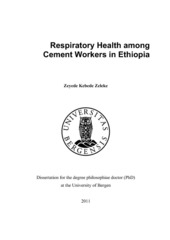| dc.contributor.author | Zeleke, Zeyede K. | en_US |
| dc.date.accessioned | 2011-11-16T10:15:11Z | |
| dc.date.available | 2011-11-16T10:15:11Z | |
| dc.date.issued | 2011-11-04 | eng |
| dc.identifier.isbn | 978-82-308-1868-8 (printed version) | en_US |
| dc.identifier.uri | https://hdl.handle.net/1956/5195 | |
| dc.description.abstract | Background: Little is known on dust exposure and respiratory health among cement cleaners. There are only a few follow-up studies on respiratory health among cement factory workers and also studies on acute effects of cement dust exposure are limited in numbers. Objective: This study aimed at assessing cement dust exposure and adverse respiratory health effects among Ethiopian cement production workers, with particular focus on cement cleaners. Method: The first paper was a combined cross-sectional and cross-shift study. Forty exposed cement production workers from the crusher and packing sections and 20 controls from the guards were included. Full-shift personal total dust was measured in the breathing zone of the workers and Peak expiratory flow (PEF) was measured for all selected workers before and after the shift. A modified respiratory symptom score questionnaire was used to assess acute respiratory symptoms experienced at the end of the work shift. The second paper comprises an exposure assessment carried out in two cement factories (A and B). Personal full-shift samples of total (n=150) and respirable dust (n=36) were taken in the breathing zone of 105 cement workers. The third paper was a follow-up study, 112 personal total dust samples were collected from 46 workers. In total 127 workers; 56 cleaners, 44 cement production workers and 27 controls were randomly selected and examined for lung function and interviewed about chronic respiratory symptoms at baseline in 2009. Of these, 91 workers; 38 cement cleaners, 33 cement production workers and 20 controls were reexamined with the same methods one year later. Results: In the first paper we found that the exposed workers had considerably higher geometric mean (GM) total dust exposure (38.6 mg/m3 and 18.5 mg/m3 in the crusher and packing, respectively) than the controls (0.4 mg/m3). Stuffy nose (85 %), shortness of breath (47 %) and sneezing (45 %) were the most prevalent acute respiratory symptoms among the high exposed workers. PEF decreased significantly across the shift in the high exposed group. In the second paper, cleaners had significantly higher exposure to total and respirable dust than other production workers. Among cleaners, the GM for total and respirable dust exposure were 549 and 6.8 mg/m3 in Factory A and 153 and 2.8 mg/m3 in Factory B. Temporal variability (within-worker) dominated the variability in the cleaners’ total dust exposure. The distance from machines while performing cleaning tasks and the fraction of working hours spent on cleaning explained about 73 % of the temporal variability in total dust exposure among cleaners. Only 7 % of the cement production workers used respiratory protective devices. In the follow-up study, total GM dust exposure among cleaners was 432 mg/m3. The levels were considerably lower among the production workers (GM=8.2 mg/m3), but still 48% exceeded 10 mg/m3. The prevalence of all the chronic respiratory symptoms among both cleaners and production workers was significantly higher than among the controls. Forced Expiratory Volume in one second (FEV1) and FEV1/ Forced Vital Capacity (FEV1/FVC) were significantly reduced from 2009 to 2010 among the cleaners and production workers, but not among the controls. Conclusion This study has shown increased prevalence of acute and chronic respiratory symptoms as well as reduced lung function among dust exposed cement production workers and excessively exposed cleaners than among the less exposed controls. It is likely that the adverse respiratory health effects are related to the dust exposure. | en_US |
| dc.language.iso | eng | eng |
| dc.publisher | The University of Bergen | eng |
| dc.relation.haspart | Paper I: Zeleke Z, Moen BE, Bratveit M. Cement dust exposure and acute lung function: A cross shift study. BMC Pulmonary Medicine 10(19), April 2010. The article is available at: <a href="http://hdl.handle.net/1956/4367" target="blank">http://hdl.handle.net/1956/4367</a> | en_US |
| dc.relation.haspart | Paper II: Zeleke Z, Moen BE, Bratveit M. Excessive exposure to dust among cleaners in the Ethiopian cement industry. Journal of Occupational and Environmental Hygiene 8(9): 544-550, August 2011. Full text not available in BORA due to publisher restrictions. The article is available at: <a href="http://dx.doi.org/10.1080/15459624.2011.601711 " target="blank"> http://dx.doi.org/10.1080/15459624.2011.601711 </a> | en_US |
| dc.relation.haspart | Paper III: Zeleke Z, Moen BE, Bratveit M. Lung function reduction and chronic respiratory symptoms among workers in the cement industry: A Follow up study. BMC Pulmonary Medicine 11(50), November 2011. The article is available at: <a href="http://hdl.handle.net/1956/5194" target="blank">http://hdl.handle.net/1956/5194</a> | en_US |
| dc.title | Respiratory Health among Cement Workers in Ethiopia | en_US |
| dc.type | Doctoral thesis | |
| dc.rights.holder | Copyright the author. All rights reserved | |
| dc.subject.nsi | VDP::Medical disciplines: 700::Clinical medical disciplines: 750::Lung diseases: 777 | eng |
